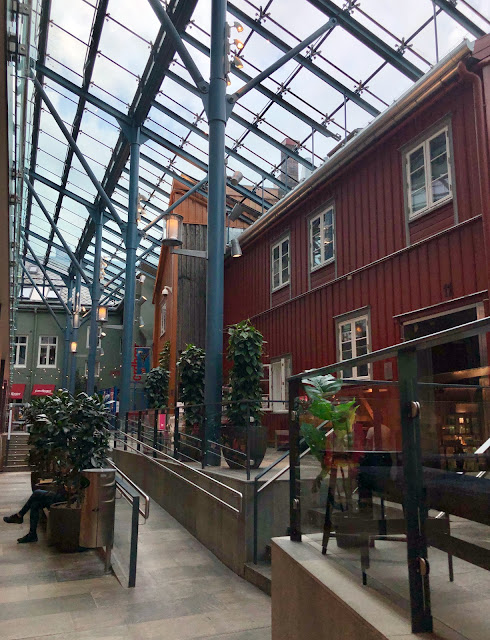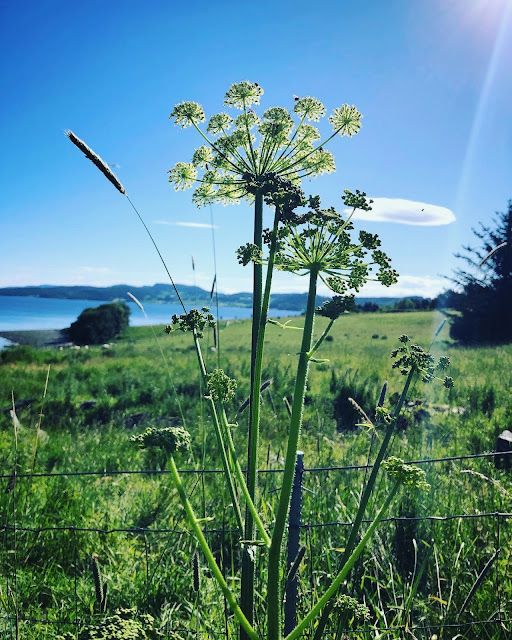 |
| 'Trondheim warehouses with seagull' 😀 |
Yes, dear Reader, that's right - after a Covid-enforced international travel drought of more than two years, we have recently returned from our second trip to Norway in the space of three months!
This second jaunt was extravagantly brief - just four days. This is a duration we would not ordinarily consider for financial and environmental reasons both; if you're going to get on a plane, at least stay a while and make the environmental damage worthwhile. However, on this occasion we had no choice. Whilst visiting Marion and Erik in late March they invited us to return in early July to celebrate their 40th wedding anniversary. Those invited were a select group: there would be just 14 of us. We were all to meet on the island of Tautra, about 45 minutes drive from Norway's third largest city, Trondheim. Central to the weekend would be a celebratory dinner and various activities, and an overnight stay.
So Kevin requested, and was granted, permission to take two days of special leave as this was just a week prior to Frensham Heights closing for the academic year. Thus we flew from Gatwick to Trondheim on Friday, and returned on Monday.
 |
| Climbing hydrangea flourishing on this cottage in Trondheim's Old Town |
 |
| Cafés, bicycle stores and charming houses and apartment buildings abound in the area on the eastern side of the Gamle Bybroa (Old Town Bridge) |
 |
| Traditional timber house in Bakklandet (the area known as the 'old town') in Trondheim |
 |
| Trondheim Public Library |
 |
| Tourist boutique House of Norway in Trondheim (note my caption!) |
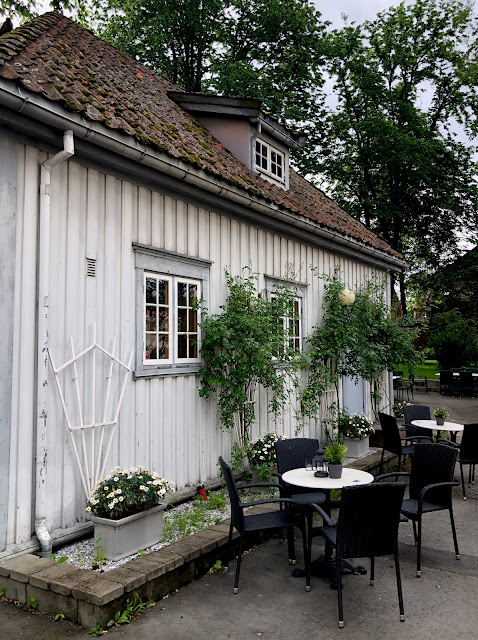 |
| This is in the middle of the city - an original timber building now operating as a café |
 |
| The dockland area of Solsiden has in recent years been redeveloped and now offers an abundance of bars, restaurants and apartments |
We are no strangers to Trondheim (population 183,000). In fact I think I've probably visited at least five times over the past four decades. It's a very nice small city, chock-full of history, with many pedestrianised areas as well as being very happily positioned on the Trondheim Fjord in central Norway. In case you're not familiar with the geography of Norway, the country is shaped like a long-handled spoon, or a tadpole. Trondheim lies at the top of the bowl of the spoon, or the bit where the tadpole's long tail joins the head. It's about three hours' drive from Marion and Erik's home a bit further south-west.
Trondheim is still about a seven-hour drive south of the Arctic Circle where the Midnight Sun region officially begins, however the sun does only sink below the horizon for a couple of hours in summer, and it's never actually dark. This in isolation is not a big deal for me; I've been visiting Norway during that permanent daylight for close to 40 years now. However, endless light in conjunction with a heatwave does not a happy Maree make...
It was 27ºC and very humid when we arrived on Friday (my least favourite combination of weather factors), so TMC* was in full force. Nonetheless, we had limited time in central Trondheim as we would be picked up by Marion and Erik late the next morning, so off we trudged, determined to make the most of our precious hours.
* The Maree Curse - wherever I travel, unusually hot temperatures follow
 |
| Another view of Trondheim's famous timber warehouses along the Nid River (photo taken from Gamle Bybroa) |
 |
| One of Trondheim's warehouses close up - in varying stages of decoration. Maybe they're deciding on a new colour scheme? |
 |
| Pub right next to Gamla Bybroen (the Old Town Bridge) in Trondheim. That walkway down to this covered pontoon is s-t-e-e-p. Not for the faint-hearted after a few drinks, or for Donald Trump |
Of course, our first stop was Nidelva (the River Nid), lined with centuries-old warehouses painted in vibrant, traditional colours. The view along the canal is iconic and instantly recognisable not only within Norway but internationally. These buildings were originally used for storage of wares such as fish, hides, sugar and salt, and for conducting business connected with those industries. Some of the warehouses have been converted to apartments, restaurants and pubs, but many continue to be in some way tied to historical purposes.
Crossing Gamle Bybroa (the Old Town Bridge) we explored the old town, which is an Instagrammer's dream. Quaint, brightly coloured timber houses are nestled along cobbled streets, with locals ambling along either on foot or by bicycle. There is very little car traffic, an absolute delight in our modern age.
I had steered us in this direction because I was certain I could find one of Trondheim's quirkier attractions, discovered on my first or second visit here - a bicycle lift that gives cyclists a very welcome boost (particularly on a hot and sticky day) up one of the city's steepest streets, all free of charge. I've said it before many times, but I'll say it again: this is one very civilised country.
To see the bicycle lift in action, click on the short video below.
 |
| Kevin reading up on how to use the CycloCable bicycle lift in Trondheim. That hill doesn't look too steep in a photograph. Trust me, it is. |
Whilst on the topic of cycling, Kevin was gratified to discover that Trondheim is one of the most cycling-friendly places we've ever visited. All over the city are facilities that (a) thank you for cycling rather than using motorised transport, and (b) give you free storage.
Other cities take note:
If you're serious about minimising car traffic and encouraging cycling, this is the kind of stuff you've got to provide.
Other countries take note:
This is not one of the more traditional cycling countries of the world. Unlike the bike-friendly flat landscape of the low countries (Holland, Belgium etc), this is vertiginous Norway. You can barely travel half a kilometre in any direction without coming across a hill or mountain.
This is also OECD country Norway - twelfth largest producer of oil in the world. Yet since the 1990s Norway has realised urgent action is required to avert global climate catastrophe, and they've put their money where their mouth is. By 2025 - just 2.5 years away - ALL new cars sold in this country will need to be zero-emission (electric or hydrogen). And indeed by February this year there were already more than 470,000 registered battery electric cars in Norway (population 5.4 million), representing a 64 per cent market share of new vehicles for 2021. This is what is possible when a country puts the environment before profits. And remember: it's a country whose primary wealth stems from oil, yet Norway is doing the right thing for the planet.
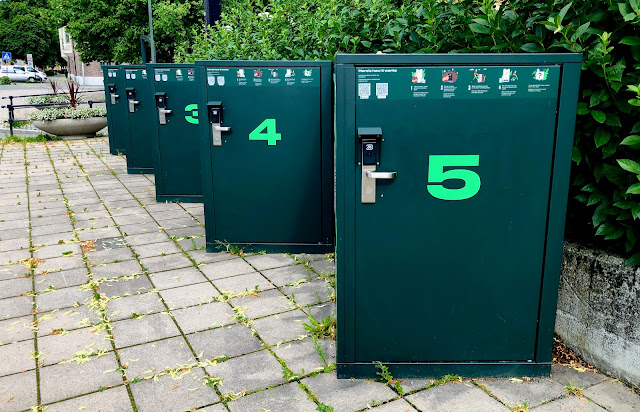 |
| Typically stylish Scandinavia: Even the way they've diagonally staggered these bike lockers is visually appealing! |
 |
| FREE bike hotel - in Trondheim |
 |
| Entrance to a secure, totally FREE 'bike hotel' in Trondheim |
 |
| Another set of bike lockers - with turf roof for insulation, no less! |
Trondheim's not just about cute buildings and bikes, however! No visit to this city would be complete without seeing Nidaros Domkirke (Nidaros* Cathedral), which was constructed over a period of about 230 years (1070 to 1300), over the burial site of King Olav II who reigned from 1015–1028 and is the patron saint of Norway. Nidaros is the venue for consecration of all new monarchs in Norway.
* Nidaros was the mediaeval name of the city
Indeed, you read that correctly - this church has been standing here in one form or another for nearly a thousand years. This version of the building was constructed primarily in the mid 19th century, after a series of fires and lightning strikes destroyed all but the walls in the early 18th century.
We didn't have time to justify paying the fee to go inside on this occasion (though we did a tour many years ago), but even just wandering around the outside of this impressive romanesque and gothic building is fascinating. I was interested in the dozens of statues that line the front of the building, and in particular my eye landed upon a chap holding a tray with three heads on it. Apparently this statue represents Bishop Sigurd, an English priest who travelled to Norway in 995. Apparently whilst travelling Sigurd's three companions (either helpers or his nephews - the jury's out on that) were murdered and then beheaded. Their heads were placed in a wooden vessel and sunk in a lake, I suppose to hide the crime. According to legend, when Sigurd passed by said lake, the heads floated to the surface and told him who had murdered them! You're welcome.
 |
| View of the western side of Nidaros Cathedral. The cathedral has been standing in one form or another since 1070 |
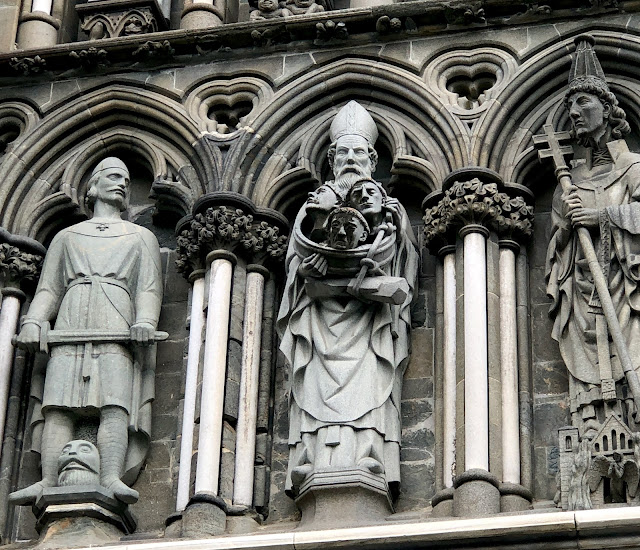 |
| Detail of statuary at the front of Nidaros Cathedral in Trondheim, with Sigurd in the centre (refer to the tale above which is a tad gruesome!) |
 |
| Fabulous metal decoration on doors at Nidaros Cathedral |
 |
| Nidaros Cathedral door (detail) |
 |
| Aruncus dioicus 'Goat's Beard' in the churchyard of Nidaros Cathedral in Trondheim. This was in flower all over the Trondheim region when we visited in early July |
 |
| Take a look at the size of that peony! In the churchyard of Nidaros Cathedral in Trondheim |
 |
| The author at the northern entrance to Nidaros Cathedral in Trondheim |
There's a thriving arts and artisan scene in Trondheim too, including one of the largest collections of contemporary art in public spaces in all of Norway. On this occasion we didn't have time to visit any galleries but will include them in the itinerary for the next one. The city itself - with its beautiful architecture spanning centuries - is, for me, like one big open-air art gallery.
 |
| Verdens Teatret (The World Theatre) / Film Teatret (The Film Theatre), constructed in 1911. It has operated as a cinema since the glory days of the 1920s and is still going - now known as Prinsen Kino |
 |
| This wonderfully vernacular piece of Norwegian jewellery caught my eye, in the window of Henrik Møller on Munkegata in Trondheim (see below) |
 |
| Nordenfjeldske Kunstindustrimuseum (The Mountainous North Art Industry Museum), currently closed for renovation |
And overall, well the architecture speaks volumes about this lovely city, doesn't it? It spans modest timber cottages to fabulous Art Nouveau apartment blocks, to ultra-modern structures which meet Norway's requirement that buildings must function for the present age and the future. Not every historic building needs to be preserved as a museum, and all new buildings should have the minimum impact on the planet.
As much as I love Britain's rich history of architecture, there is too much focus on preserving every building with a modicum of age, regardless of whether it has any historical significance or not - at the expense of people being able to live in comfort and with some kind of environmental integrity.
 |
| Trondheim's streets are graced with a large number of buildings from the Art Nouveau period |
 |
| Arkitekt Christies Gate (Architect Christie's Street), Trondheim. I love this street with its view over the hilly suburbs, and particularly the building on the right (see detailed pictures below) |
 |
| Art Nouveau fabulousness in Trondheim - entry to 4b Arkitekt Christies Gate |
 |
| Balconies on Arkitekt Christies Gate |
 |
| Detail of front entry to 4b Arkitekt Christies Gate in Trondheim |
 |
| Proving that you don't necessarily require a gigantic garden to enjoy a bit of al fresco in the city. Let's be generous and call this a 'terrace garden' in the Old Town, Trondheim |
 |
| Klubselskabet Harmonien on Sverres Gate in Trondheim. This is a private members' club (after the English style), established in 1813 |
 |
| The wonderfully ornate doors of the Jewish Museum in Trondheim |
.jpeg) | ||||
| Minty green modernity in Trondheim: Thora Storm Videregårende Skole (Thora Storm Senior High School) |
 |
| This is a hospital right in central Trondheim. It's horrible to be unwell but if you've got to be in hospital, this is the kind of outlook you want |
Our single night spent in Trondheim itself was not a restful one; what with it being the hottest day of the year and a Friday night, I am happy to report that Trondheim's citizens maintained the Norwegian commitment to making the absolute best opportunity of 'good' weather. Not only was every bar, restaurant and public space filled with revellers, that sense of joie de vivre lasted until, ooh, about 3am. What with it never actually getting dark, and who knows when the next really warm, sunny day will eventuate, there were people enjoying drinks and supper, catching buses, cycling down the streets and generally living life to the full until the wee small hours.
I'm all for people having fun, but as our hotel was not air conditioned and the gigantic, double-glazed window could only be opened about 10cm at the very top near the ceiling, our room was waaaaaaaay warmer than I can tolerate for sleep. Combine that with the perfectly pleasant noise (in normal circumstances) of people enjoying themselves in a reasonably civilised fashion, and I was lucky to catch three hours of sleep.
 |
| View from our hotel room in Trondheim - at 11:45pm, as the sun was setting |
Despite the lack of sleep both Kevin and I managed to do justice to our hotel's excellent breakfast buffet - truly one of the best I've ever experienced, and this was a modest hotel, nothing fancy. Usually breakfast is automatically included in the Norwegian room rate and you would have to be mad not to take advantage.
If you've never experienced breakfast in a hotel in Norway, my goodness - that's one to put on the bucket list. Even the most modest establishment will have a buffet with a variety of cereals, fruit, breads and crispbread, pastries and cakes, pancakes, cold meats, cheeses, herring, smoked salmon, boiled eggs, salad vegetables, jams and often a hot selection that caters more to British or American habits. Plus juice, milk, tea and coffee.
It's always easy to spot a Scandinavian Breakfast Virgin: they load up their plate and attempt to totter unsteadily back to their table without dropping anything, which really is a cultural faux pas. The trick is to only take a small sample of one or two things at a time, and return again and again to try other bits - I mean, you're not being timed and nobody's checking how many trips you make to the buffet!
So... after eating and drinking our fill fairly early, we took another spin around the city for an hour or so, before returning to the hotel and checking out. We were collected at 11:00 on the dot (how I love the precise punctuality of the Scandinavians! That's obviously where I get it from - Dad's genes) by Marion and Erik, and we drove out to Tautra.
 |
| How idyllic is this? Al fresco dining in the courtyard of the historic kafe building at Klostergården Tautra |
 |
| Cistercian abbey ruins in the grounds of Klostergården Tautra, near Trondheim |
 |
| Holy cow... the prices in the gift shop were eye-wateringly expensive! But many lovely things, all the same |
The venue for the celebration was an old smallholding called Klostergården Tautra, which just happens to have cistercian abbey ruins within its grounds! The ruins are the same age as those at Waverley Abbey, which is just a five-minute drive from where we live here in Surrey, and Tautra is on the pilgrim route known as St Olav's Way.
Klostergården Tautra is a family-run business offering accommodation and dining, with a focus on using local foods. They specialise in incorporating the local seaweed into dishes. There is a micro-brewery producing 18 regular varieties of beer using a specifically Norwegian brewing method. The farm also makes juices, cordials, jams and cheese.
Not long after we and the rest of the family members arrived, it began to pour with rain. And I mean pour. So we adapted the itinerary slightly, with a local historian giving us the history of the area in the comfort of our guesthouse, before we all braved the elements and car-pooled to drive about ten minutes to visit the new abbey (now a female order of just 11 nuns), architecturally designed in modern Scandinavian style. Being the only (lapsed) Catholic in a group of Lutherans and atheists, I found myself dredging up various bits of long-forgotten catechism from the depths of my brain, and translating them into Norwegian for the edification of my relatives! I certainly didn't anticipate such an activity when we planned our long weekend in Trondheim.
We then drove on for another few minutes to visit Logtun Kirke, constructed in about 1500, although records indicate a church has stood on the site since around 1150.
 |
| Bedroom view on a lovely rainy afternoon, a relief after the heat and humidity of the previous day. See those cute sheep? They all have bells around their necks... |
 |
| Interior of Tautra Mariakloster, opened in 2006 |
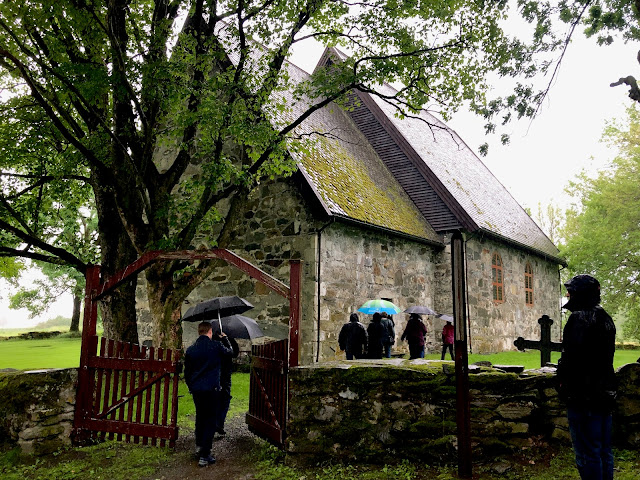 |
| Umbrellas at the ready for our guided tour of Logtun Kirke, constructed around 1500 |
 |
| The altar in Logtun Kirke on Tautra, near Trondheim. The very ornate altarpiece was carved in 1652 and decorated in 1655 |
 |
| Traditional paintwork on a farm building near Logtun Kirke on Tautra |
And so it was a race back to our rooms to don our finery for the celebratory dinner, where Erik made a short welcome speech and toast, and eldest son Jo Eirik gave a longer and very charming tribute to his parents.
The food was excellent and plentiful, and it suited the family occasion that the menu was an elevated version of traditional Norwegian fare, rather than haute cuisine. The ubiquitous Norwegian coffee and cake were served at about 9pm, back in the comfort of our guesthouse accommodation where everybody was able to relax and chat until well after midnight. Let me tell you, those cakes were numerous, gobsmackingly delicious and outrageously high calorie, served with whipped cream and Marion's multebær (cloudberries) which had been picked by Marion's own fair hand up in Finnmark late last summer and preserved. What a treat!
Unfortunately I had a second night of limited sleep, despite it being much cooler than our night in the city. The culprits were the those cute sheep with bells on their necks. As it never gets dark in summer, I discovered the sheep don't sleep - they graze contentedly throughout the small hours, with each step and head movement creating an orchestra of romantic goats-on-Swiss-mountains sounds. All very appealing, but not when you've had only three hours of sleep the previous night, and having been woken by the bells, the brilliant sunshine from about 3am onwards serves to keep you awake!
 |
| After Saturday night's festivities we woke to a beautiful, sunny morning with a fairly moderate summer temperature |
 |
| Close-up of the gorgeous kafe building at Klostergården Tautra |
 |
| A modest but delicious breakfast buffet at Klostergården Tautra - in the beautiful café |
 |
| View of the Trondheim Fjord from our bedroom window at a bit before 3am - on Tautra, near Trondheim |
After breakfast in the gorgeous kafe building at Klostergården, everybody went their separate ways to head home. Marion and Erik had arranged to spend the day with us before driving back to their cabin in Oppdal, and we had made plans to catch up with friends Grete and Gunnar in their lovely home in the Trondheim suburbs in the late afternoon.
So we had a leisurely day, with Erik chauffering us eastwards beyond Trondheim's environs for a couple of hours. We decided to nip over the border into Sweden for lunch - as you do - into the winter ski resort town of Storlien where Norwegians may be found all year round, taking advantage of 'Swedish prices' (something that is used as a catch-phrase for bargain stuff in Norway) and in particular stocking up on gigantic barrels of sweets as Sweden does not have a sugar tax, and Norway does.
We hadn't caught up with Grete and Gunnar for a number of years, and as is standard with Norwegian hospitality, they went all out - serving us an early supper followed by the world’s most delicious, light-as-air, home baked hazelnut swiss roll served with macerated local strawberries... the taste of summer on a plate.
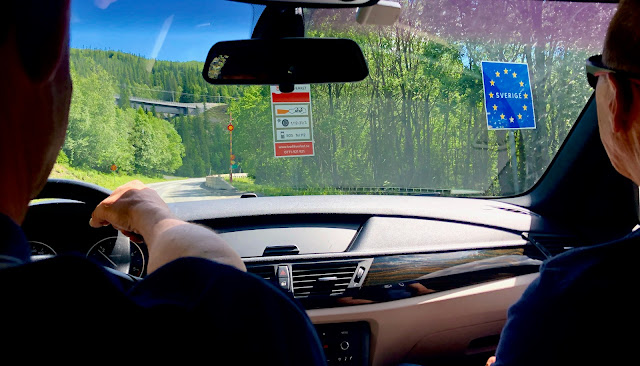 |
| Crossing the border into Sweden to take advantage of 'Swedish prices' for lunch 🤣 |
Well, there you have it - a long weekend in Norway filled with sunshine, rain, family, friends, excellent food and drink, and a side-trip into Sweden for about an hour.
We really felt honoured to be included in the group of close family who were hosted by Marion and Erik on Tautra, and I was very pleased to meet - at long last - my first cousin Åge (Marion's brother) and his family, who had travelled up from their home south of Oslo. We'd been meant to meet several times but family illness and Covid scuppered those plans in the past few years.
 |
| Snow on Norway's mountains, despite a couple of days of very warm summer weather |
 |
| I'm smiling for the selfie in front of Trondheim's beautiful timber warehouses, but inwardly I'm screaming 'Errrrggghhhh... this humidity!!!' |
I have some updates on life here in Surrey, but will save that for another post.
Until next time,
- Maree xo




